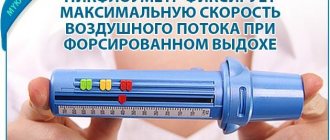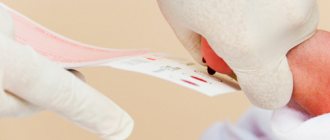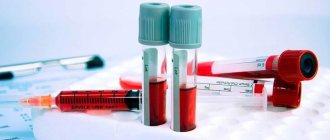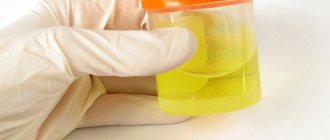Body temperature is one of the most important indicators of health. Since childhood, we have become accustomed to measuring our temperature if our health worsens or signs of illness appear. It is not surprising that we subsequently do the same with our children. The baby cannot tell if something hurts, so he has to rely on the numbers displayed by the thermometer. But the temperature norms for children are somewhat different from adults, which parents often forget about.
What temperature is normal for a child?
Everyone knows that the normal temperature of an adult when measured in the armpit is up to 37°C. Any increase in it is usually associated with diseases and pathological processes in the body. When it comes to children, readings above 37°C are not always a sign of illness and require immediate action. It is worth considering that:
- Immediately after the baby is born, its temperature drops by 1-2°C;
- During the first day of a newborn’s life, the indicator increases by 1-2°C;
- On days 3-4, the temperature may rise to 38°C and even 39°C - this is how the imperfect thermoregulation system seeks the optimal balance, reacting to the new environment;
- Only by 3 months does the temperature stabilize and the surges practically stop.

But many factors influence temperature readings in children. This includes the indoor microclimate, food intake, and time of day. For example, after feeding, the temperature may rise, in the morning it is usually lower, and in the evening it rises again. Typically fluctuations occur within 0.6°C. The average for childhood, which is considered normal, is 37°C, but 37.7 when measured rectally or with an ear thermometer is not a cause for concern if the baby does not show other signs of discomfort.
Thermometry techniques in pediatrics
Fever is one of the most common reasons for visiting a doctor. At the same time, more than a century after the introduction of the mercury thermometer by Carl Wunderlich, many uncertainties remain regarding the methods of temperature measurement. Measuring rectal temperature using a mercury thermometer remained the reference method for a long time. But the risks of nosocomial infection and mercury pollution have been the reason for its prohibition since 1996, following the Report of the French High Council of Public Hygiene (official bulletin of March 28, 1996). This article looks at the different types of thermometry that exist in France today.
2. NORMAL BODY TEMPERATURE AND FEVER 2.1. Center of Thermoregulation Man is a homeothermic creature, that is, his central temperature remains stable no matter the ambient temperature. In a healthy person, body temperature is regulated within a narrow limit of 37°C + 1°C, in accordance with the circadian rhythm, the amplitude of which in a child is 0.5 to 0.6°C. This rhythm does not exist in the newborn but appears during the first weeks of life. The balance between thermogenesis (production of heat through biochemical reactions at the level of brown fat and muscle) and thermolysis (loss of heat through the skin and respiration) is ensured by the thermoregulatory center. It is located in the preoptic area of the anterior lobe of the hypothalamus and is a real thermostat that ensures temperature equilibrium set within 37 ° C. Its destruction in the experiment leads to instability of the internal temperature, which reflects the external temperature. Vasomotricitis regulates cutaneous temperature exchange through the skin depending on the ambient temperature in the range from 20 to 30 ° C (heat generation during vasodilation and heat savings during vasoconstriction). Sweating occurs when evaporation is impaired when the ambient temperature is above 35°C. Conversely, increased muscle tone then yeast increases heat production. Numerous factors raise body temperature, such as diet, stress, anger or exercise.
The average value of 37°C for normal body temperature, established by C. Wunderlich in the 19th century, based on more than one million armpit measurements taken on more than 25,000 individuals, has been called into question. Mackowiak et al. established an average value of 36.8°C + 0.4°C with extreme values of 36.8°C and 37.7°C based on electronic measurements of buccal temperature in 148 students aged 18 to 40 years (700 measurements taken during the semester). The same authors found that temperature does not change with age.
2. 2. Hyperthermia and fever Hyperthermia is associated with the inability of the body to regulate its caloric balance, most often with insufficient thermolysis, for example, due to very high ambient temperatures or very humid atmospheric air, making sweating ineffective. In this case, the thermal equilibration point does not change.
In case of fever, in contrast, the thermostat of the thermoregulation center is deregulated and the thermal equilibration point shifts upward. This causes the anterior lobe of the hypothalamus to release nerve impulses aimed at increasing heat production in order to raise the central temperature to a new level of equilibrium. Hence, vasoconstriction occurs, aimed at reducing thermolysis and yeast, increasing thermogenesis. Most often, we can talk about the body’s adaptive reaction to a pathological situation.
By 2004, the definition of fever, particularly in children, remained unclear due to the lack of large, comprehensive studies. Darowski et al. It is believed that a patient is considered febrile if his morning rectal temperature is above 37.5°C or his axillary morning temperature is above 37.9°C. According to Mackowiak, the upper limit of normal buccal or axillary temperature in the morning should not exceed 37.2 o C and 37.7 o C in the afternoon. Petersdorf defines fever by a body temperature greater than or equal to 38.3o C. In an infant and child, fever is said to be at a temperature above 37.8o C and hyperthermia at a temperature above 41o C.
3. LOCATIONS FOR MEASURING BODY TEMPERATURE Any diagnostic approach for a child with fever involves reliable, accurate and reproductive temperature measurement. Ideally, temperature should be measured at the level of the hypothalamus, where the thermoregulation centers are located. This core temperature is best determined invasively at the level of the pulmonary artery or lower esophagus. Bladder temperature, which largely depends on urine flow, seems less reliable. Measurement of pulmonary artery blood temperature is considered to be the most representative of core temperature, but this can only be taken seriously in the context of resuscitation or surgery. In order for the measurement to be reliable, it is necessary that the measurement site is well vascularized and isolated from the external environment, and does not pose any risk to the patient. Sites such as the buccal, rectal, and tympanic meet these criteria.
3.1. Axillary temperature The reliability of axillary measurements is controversial. A necessary condition for reliability is that the thermometer must remain in place for at least two minutes, a duration that is never observed in practice. In addition, we are talking about the measurement site most susceptible to the influence of external temperature, especially in very thin persons or when tight closure of the axillary cavity is impossible or, conversely, in obese persons due to the presence of a fatty pad. This explains its poor correlation with the rectal site, with a difference approaching 1°C, and its predisposition to the risk of false-negative results. The values obtained are lower than in other measurement locations and in practice it is necessary to add 0.5 ° C to compare with the rectal temperature. In a comparative analysis of the rectal site, Craig found a mean difference of 0.92°C in children, but only 0.17°C in newborns. This may be due to more stringent requirements for temperature measurement in neonatology departments.
3.2. Rectal Temperature This is the site of measurement where the temperature is most elevated. As in the entire digestive infragastric (located below the stomach) tract, it turns out to be 0.2° C higher than the blood temperature of the pulmonary artery in apyretic individuals. This is possibly due to local thermogenesis and significant variations in local blood flow, which can cause variations of more than 0.5°C in rectal temperature. The main disadvantage is its thermal inertia, due to the fact that the rectum is an organ filled with air and sometimes material, which can lead to a delay in alignment with a difference that can reach as much as 2.4 ° C from the blood temperature of the pulmonary artery at the time of temperature variations. In a state of shock, a drop in the blood supply to the rectum is accompanied by a certain degree of exclusion and in some observations the difference can reach almost 3o C (38.7o C in the rectum and 41.6o C in the pulmonary artery). Moreover, the rectum reflects variations in central temperature with a delay of 30-45 minutes due to its distance from the center of thermoregulation.
For accurate measurements, certain conditions must be met. The temperature is stable only if it is measured at a depth of more than 8 cm from the anal verge. With the probe positioned usually at a distance of 1 cm and 2.5 cm from the anal verge, the temperature can vary within 0.8 ° C depending on the position of the thermometer, and we are more likely talking about measuring anal rather than rectal temperature. The minimum duration of the process must be at least three minutes. The few studies focusing on measurement time convincingly show that rectal temperature actually equilibrates only after nine minutes in apyretic patients and after six minutes in those with a febrile condition.
3.3. Buccal temperature The buccal route is the most easily accessible measurement site. However, it can only be used in children with compliance due to the potential risk of inhalation of the device. The resulting values are lower by 0.1°C - 0.4°C for measurements taken in the esophagus, aorta or rectum. In practice, 0.5°C is added to obtain a measurement comparable to that obtained in the rectum. Measuring buccal temperature requires careful methodology: the thermometric probe is placed sublingually and posterolateral to the frenulum in contact with the lingual artery, the lips are closed to avoid exchange with the external environment for a minute. Despite these precautions, this measurement is subject to numerous sources of measurement error. Buccal temperature is heterogeneous with thermal pockets created between the deep lingual artery and the sublingual artery, which explains a decrease of 1 - 0.5 ° C from the result at the ideal measurement point in close contact with the sublingual artery. Buccal temperature is modified by ambient temperature under the influence of inhaled air and changes in the temperature of the internal carotid. It also varies depending on the frequency of breathing and previous drinking of cold or hot drinks, with a return to the original temperature within a few tens of minutes. This results in an underestimation of febrile conditions, which can account for 15% of cases, that is, one patient out of every six is diagnosed as non-febrile, despite the fact that in reality his temperature is above 38o C.
3.4. Tympanic temperature Its definition perfectly reflects the central temperature, since the tympanum has the same vascularization as the hypothalamus. Variations occur as quickly as at the level of central regulators. Measurement within a second allows it to be performed on sleeping, sedated or agitated and uncooperative patients. Optimal measurement requires that the thermometer probe be placed directly at the tympanic membrane, that is, it is best that the probe is seen at right angles above the tympanic membrane as it passes through the wide auditory meatus. But these conditions are determined by numerous anatomical variations with the external auditory canal located at an angle of 60° on the membrane. In newborns, this angle is very acute and becomes relatively open only by the age of seven-nine. These anatomical variations likely explain why this measurement only averagely correlates with pulmonary artery blood temperature.
In conclusion, from studies examining these different temperature measurement sites, it appears that measurement at the rectal site is most correlated with the pulmonary artery site, although extremely large discrepancies may occur at the axillary, buccal, or tympanic sites.
4. AVAILABLE METHODS OF THERMOMETRY Currently there are four of them: liquid crystal, chemical and, above all, electronic and infrared. 4.1. Liquid crystal thermometer The liquid crystal thermometer, which is usually applied to the forehead, is easy to use and safe. It usually consists of six sets of liquid crystals calibrated for color development depending on the corresponding temperature: 35, 36, 37, 38, 39, 40 ° C. The sensitivity of this thermometer is weak at 89% and the specificity is 78%. In addition, the positive predictive value, or ability to diagnose a temperature less than 38°C, is 57% with a significant risk of false negatives.
These results raise the problem of refining skin temperature, which is not measured reliably, which largely depends on local circulation conditions, transcription and ambient temperature. The magnitude of false-negative or false-positive results is estimated at 47%, which is associated with a risk of error of 1 in 2.
4.2. Phase change thermometer or matrice de point The phase change thermometer is intended for individual use in the form of a plastic bracelet, on which 50 thermosensitive points are recorded covered with a substance that turns from blue to white at intervals of 0.1 ° C in the temperature range from 35.5 ° C to 40.4o C. Reading the temperature is quite simple by counting the colored dots. This thermometer was used to measure oral temperature, but its measurement results differed by at least 0.4°C from the readings given by the electronic thermometer. It can also be used for the axillary site. Compared to the mercury axillary thermometer, it has better performance with a sensitivity of 92% and specificity of 85% and, above all, good predictive positive values of 83%. This is probably the best method for determining axillary temperature due to its flat shape. “Unfortunately, this method has not been adequately evaluated, although it could be a valuable tool in certain situations, particularly in emergency departments” (Consumer Safety Commission, Report on the Toxicity of Mercury Thermometers and Alternative Approaches to Measuring Body Temperature, 9 September 1998).
4.3. Electronic thermometer The electronic thermometer replaced the mercury one, which was associated with a considerable risk of nosocomial infections, ulcerations or perforations of the rectum, mercury peritonitis and, above all, mercury emissions and its potential complications for humans. An electronic thermometer eliminates this last risk. The use of prophylaxis through the use of an individual probe makes the risk of nosocomial infection negligible, but does not eliminate the risks of thermometric ulceration. This device allows you to determine temperatures within the range of 32 and 43.9 ° C with an accuracy of 0.1 ° C. The result is obtained either by continuous measurement before equilibration (continuous type), or by extrapolation from the slope of the thermal growth curve (predictive type), which allows you to reduce measurement time from three minutes to 30 seconds. At the same time, continuous measurements are more reliable than extrapolative ones, which give values higher by 0.2 - 0.3 o C. This discrepancy does not pose a problem in clinical practice.
The electronic thermometer can be used submuscularly, buccally and rectally. Craig's meta-analysis, which compared electronic thermometer temperature measurements at the axillary site with the rectal site, found a mean difference of 0.85°C with extreme values of -0.19 and 1.9°C, which is apparently higher than the results obtained when using a mercury thermometer (0.25°C on average with extremes between -0.15 and 0.5°C). Measurement at the axillary site with an electronic thermometer is unreliable. Also in the buccal site, the reference measurement with an oral mercury thermometer underestimated temperatures above 38°C, while overestimating low temperatures within 36°C.
The sucette (pacifier) thermometer (Pacifier in Anglo-Saxon literature) is a modification of the electronic thermometer. By combining a pacifier and a thermometer, he was allowed to determine buccal temperature in young children. It should be emphasized that this device does not measure the reference buccal temperature located sublingually, but determines the sublingual temperature. This new method has been studied in a small number of scientific papers. It would be premature to recommend this type of instrument, especially since there are contradictions in the field of normalization and regulation between the requirements for medical devices and those of puericulture teats.
The electronic thermometer remains the reference device for measuring rectal temperature. Most studies report excellent correlation with mercury thermometer. The average difference between these two thermometers is -0.05°C with variations from -0.3 to 0.4°C. Recent studies, however, highlight a significant discrepancy of an average of 0.36°C with extreme values ranging from -0.516 to 1.234°C and a trend to overestimation of temperature in newborns. In addition, the measurement appears to be moderately reproducible. According to studies, from 9 to 23% of repeated measurements give a difference of at least 0.5 ° C. These results are probably associated with the use of a type of predictive data extrapolation, which made it possible to reduce measurement time due to its some inaccuracy. It would be better to use a continuous type, which records the temperature until it stabilizes, but the required measurement time will increase to three minutes.
4.4. Infrared tympanic thermometer The measurement principle of this thermometer is based on the detection of infrared radiation. It is mainly used in the tympanic site due to its ease of handling and hygiene. The tympanum (tympanic membrane), like all bodies whose temperatures are above absolute zero, emits infrared rays, the quantitative analysis of which using an integrated microprocessor makes it possible to determine the temperature of the tympanic membrane without direct contact with it, despite the fact that the ear canal has a lower temperature, rather than a membrane. The measurement is carried out in one second, which allows it to be used in non-cooperative children or sleeping children. This type of thermometer is loved by parents and children and is widely accepted.
Commercially available thermometers (see Table 1 for a non-exhaustive list) can be used depending on the temperature site one wishes to assess. In fact, these thermometers can be programmed to target core temperature (central type), oral temperature (oral type), rectal temperature (rectal type), or tympanic temperature. Depending on the type, the measurement may vary. In fact, with the central type, the values produced by the infrared thermometer are approximately 0.3 ° C higher than the reference rectal temperature, despite the fact that with the rectal type it is lower. For example, if a tympanic thermometer is programmed for the rectal type, then the temperature threshold that defines fever should be lowered to 37.7 °C relative to the reference value of 38 °C in the rectum, determined by a mercury thermometer. The oral type will give measurements that are most correlated with rectal temperature. Also, with great care, clinicians should modify their fever definition criteria depending on the type used, a delicate task in the absence of clear manufacturer recommendations. Adding to this methodological problem is the fact that all studies were conducted with thermometers for professional use. The reliability of instruments intended for public use has not been demonstrated.
The results published by the manufacturers guarantee measurement accuracy between 34 and 42°C at 0.1°C. The measurement correlates well with core temperature determined at the level of the esophagus and pulmonary artery. Numerous studies published since 1990 indicate excellent correlation with rectal temperature measurements with a digital thermometer. The rectum-tympanum difference is minimal and averages 0.08°C with insignificant deviations from 0.05 to 0.11°C and in the case of fever -0.04 with deviations between 0.12 and +0.04°C. The results obtained from the two ears are not significantly different, but the study indicates an average difference of 0.6°C from -0.8 to 0.4°C.
But these studies are mostly methodologically insufficient, due to reduced efficiency and inaccuracies regarding the technique and type used. Others highlight the lack of correlation of the measurement with respect to rectal temperature. These studies, mostly conducted prospectively in large cohorts, found sensitivity ranging from 57% to 85% and specificity ranging from 31% to 94%. The discrepancy between tympanic and rectal temperatures can reach at least 0.3°C in 62% of children and at least 0.6°C in 35% of children. In general, the tympanic temperature is lower on average by 0.3+0.5o C and the difference can reach 0.5 and 0.9o C, respectively, in 41 and 12% of individuals.
A meta-analysis of 4441 children showed a mean difference of 0.29°C (rectal value minus tympanic value). This relatively modest difference refers to a 95% confidence interval of -0.74 to 1.32. In practice, at a rectal temperature of 38°C, the tympanic temperature measured using an infrared thermometer can vary from 37.1 and 39.2°C. This results in an unacceptable number of undiagnosed febrile patients, as Brennan's study perfectly illustrates. Of those with moderate fever based on rectal temperature (38 to 39°C), 30% were not classified as febrile when measuring tympanic temperature. Among those with a rectal temperature above 39°C, 41% had tympanic measurements of 38 and 39°C, and 3% were classified as apyretic.
Some studies try to show that the meaning of measurement error varies with temperature. Tympanic temperature is on average higher than the rectal temperature in a non-febrile child, whereas it is rather lower in a febrile child. Sensitivity becomes less and less as the temperature rises, reaching 76% for fevers less than 39°C and 57% for those above 39°C. Hence, some authors recommend constantly adding 0.5 ° C to the tympanic measurement.
This is especially true for newborns and children less than three months old, when the diagnosis of fever entails significant therapeutic measures and when the measurement inaccuracy is maximum. A recent study in children from 3 to 36 months confirms that measurement inaccuracy peaks in children aged one to three years with an average of -0.16o C. This could be due to a discrepancy between the size of the tip and the narrowness of the external auditory canal, thermometer , which determines, in addition to the tympanic temperature, that of the auditory canal, which distorts the results. At the same time, Craig's meta-analysis did not find a difference and it is likely that the child's age is not the factor of variation.
The measurement technique must be strictly followed (Table 2). Sources of error are mainly poor measurement technique: underestimation in case of incomplete occlusion of the external auditory canal, use of a dirty and infrared-impenetrable probe, chewing during measurement; overestimation in case of exposure during measurement to a higher ambient temperature than that of the tympanum. The presence of wax will not affect the temperature measurement: one study, however, describes a decrease in temperature by 0.3 ° C. Surgery on the eardrum such as myrinotomy or crying does not change the measurement results. No studies have indicated an increase in temperature in the context of suppurative otitis media.
From numerous literature data it follows that measuring temperature with an infrared tympanic thermometer may be inaccurate, and even more so if the child is under three years old. This makes it necessary to emphasize that tympanic thermometry is a good tool in identifying febrile conditions, but the diagnosis of fever must be confirmed by measuring rectal temperature. This debate is, however, far from over: some authors emphasize that the poor correlation between tympanic thermometry and rectal thermometry discredits tympanic measurement; others believe that rectal temperature can no longer be considered as a reference temperature.
4.5. Gallium Thermometer Gallium is a metal that is liquid at ambient temperature and has the same heat-sensitive properties as mercury, that is, it expands as the temperature increases, which in practice raises the level in the glass tube. The metal contained in the glass tube is actually galinstan, a mixture of gallium, indium and tin. All contact with non-ferrous metals, namely aluminum, which it makes brittle, and gold, silver and copper, with which it forms compounds, should be avoided. Unlike mercury, it is not toxic to the environment or to humans, whether through contact with skin, ingestion or inhalation. This thermometer in a glass case is presented as a classic mercury thermometer. It can be sterilized without compromising its integrity, unlike an electronic thermometer, which cannot be immersed in solutions due to the presence of batteries. Its cost is slightly higher than that of a mercury thermometer. Therefore, it can be used individually for each hospitalized patient, which reduces the risk of contamination. Two studies conducted showed an excellent correlation with a mercury thermometer. In a series of 120 individuals with an average age of 61 years, the average difference between the two devices was 0.002 (0.14) °C at the rectal site, 0.8 (0.35) °C at the inguinal site, 0.1 (0.2) °C at the axillary site, and 0. 09 (0.15) o C in the oral site. Given these characteristics and the sterilization capabilities not provided for electronic and tympanic thermometers, the gallium thermometer can become widespread.
5. CONCLUSION A review of the literature shows that rectal temperature measurement remains the most accurate reflection of body temperature. Although no study can clarify whether errors associated with measurement at other sites and, especially, at the tympanic site have real clinical significance, it is nevertheless clear that in some cases they are associated with the failure to detect febrile patients. In children, the convenience of using tympanic thermometry and the short measurement time encourage its use as the first intention in identifying febrile conditions. In the context of fever or a fortiori low-grade fever, the impressions obtained from the measurements make its use unreliable. Preference should be given to measuring rectal temperature either with an electronic or gallium thermometer. The hospital use of the latter in hospitals should be properly assessed due to the possibilities of its sterilization without compromising its integrity. It would be interesting to conduct a study in children to clarify its characteristics in comparison with an electronic thermometer.
Temperature standards when measured in different parts of the body
The normal temperature in children is also determined by the method of measurement. There are several options:
- When measured in the armpit, 36-37.3°C is considered normal;
- The normal temperature when determined with an ear thermometer is 36.7-37.5 ° C;
- For rectal measurement, normal values range from 36.9 to 37.6°C;
- When measured orally, the norm is 36.6-37.2°C.
Temperature readings obtained in different parts of the body always differ, and there is nothing wrong with that either. For example, compared to the value shown by a thermometer in the armpit, the numbers when measured in the mouth will be 0.3-0.6°C higher, in the ear and rectum - by 0.6-1.2°C.
With age, normal temperature approaches adult levels. Thus, up to 3 years of age the norm is considered to be up to 37.4°C, at 6 years – already 37.0°C, and after 11 years – 36.8°C. Traditional 36.6°C when measured in the armpit is considered as the norm only after 18 years.
Techniques for measuring body temperature in children of different ages
Manipulation - Technique for measuring the body temperature of children of different ages, graphic registration. Purpose: diagnostic. Indications: doctor's orders. Contraindications: the presence of hyperemia and local inflammatory processes in the axillary area. Equipment: medical thermometer in a “clean thermometers” container, temperature log, clock, pen, temperature sheet, tray with disinfectant solution. Technique for measuring children's body temperature, algorithm of action. Preparation for the procedure: 1. Wash and dry your hands, put on gloves and a mask; 2. Take a dry, clean thermometer from the container and shake it, make sure that the mercury has dropped below 1 degree; 3. Explain to the patient the purpose and outcome of the procedure; 4. Examine the patient's axillary area; ATTENTION! In the presence of hyperemia or local inflammatory processes, temperature measurements in this area cannot be taken. 5. Wipe the patient's armpit dry; 6. Place the thermometer reservoir in the armpit so that it is in contact with the skin, press the patient's shoulder to the chest, check the position of the thermometer by running the hand along the back edge of the armpit; 7. Hold the hand of children and weakened patients; 8. Remove the thermometer after 10 minutes and determine its readings; End of procedure: 9. Record the thermometer readings in a temperature log. Infection control: 1. Shake the thermometer and immerse it in disinfectant. solution (3% chloramine solution for 5 minutes, 1% chloramine solution for | minutes, 0.5% chloramine solution for 30 minutes) - rinse the thermometer under running water; - wipe dry, place in a marked container at the bottom; - where the napkin lies; 2. Place gloves in a 3% chloramine solution for 60 minutes; 3. Treat your hands at a hygienic level. Note: body temperature in the hospital is measured 2 times a day (from 7 to 9 am and from 17 to 1 pm). Temperature can be measured in the mouth, rectum, and for children in any skin fold. Graphic recording. The temperature measurement results are transferred to a temperature sheet, where, in addition to the graphical recording of temperature measurement data ("T" scale), there are curves of pulse rate ("P" scale) and blood pressure ("BP" scale). To correctly write temperature measurement data, you should remember that the “price” of one division on the “T” scale of the temperature sheet is 0.2 degrees. The column “Day of hospital stay” is divided into 2 halves: “U” (morning) and “B” (evening). Morning temperature is recorded (in black or blue ink) in column “U”, evening temperature - “B”. When connecting the points, a temperature curve is obtained - a graph of temperature changes that reflects a certain type of temperature curve, which has diagnostic value for some diseases.
How to measure a child's temperature?
It can be quite difficult for many parents to decide how to measure their child’s temperature, especially if this is the first baby in the family. Children categorically do not want to be in one position for 10 minutes, which are needed to obtain accurate indicators. At the same time, mothers and fathers are very afraid of injuring their tiny child or breaking the thermometer.
The solution may be to measure the temperature while sleeping, but you don’t want to wake up the baby, because putting him back to sleep will not be easy. The first thing to do in such a situation is to choose the right thermometer. You should immediately abandon mercury and glass models - they are too dangerous even for adults. In addition, there are many other, more convenient thermometers:
- Digital (electronic) - they do not need to be shaken off before each use, there is no need to look closely at the scale, trying to see the indicator, mark the time and constantly look at the watch. Such a device will give a signal when the measurement process is completed and show the result in the form of numbers on a small screen, and after a while it will automatically turn off so as not to waste battery power. Additional functions: the Beurer FT 09/1 model stores the result of the last measurement in memory, and the Beurer FT 13 carries out an accelerated express measurement;
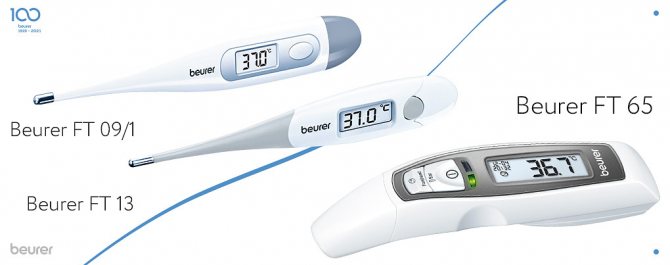
- Infrared - allows you to measure temperature in the ear or forehead using a contact method. The whole procedure takes a few seconds, the baby doesn’t even have time to start acting up. The Beurer FT 65 model stores 10 measurements in its memory, which allows you to track dynamics and also displays the date and time;
- Non-contact - measure the temperature on the forehead at a distance of 2-3 cm or 4-6 cm (depending on the model), report if normal values are exceeded. This is the same option that allows you to measure your baby’s temperature without waking him up. The Beurer FT 90 and FT 100 models have a backlit screen, making it convenient to use if the room is dark.
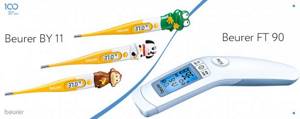
For children, you can also use the Beurer BY 11 thermometer with funny animals. This design allows you to turn the procedure into a game so that the child does not get bored.
Measurements in different parts of the body
You can measure temperature in different parts of the body:
- In the armpit - the most familiar, but not the easiest way, especially when it comes to babies;
- In the rectum - you need to choose a thermometer with a soft, disinfectable tip;
- In the ear - using an infrared thermometer;
- On the forehead - in a non-contact way.
There is also the option of measuring in the oral cavity (behind the cheek or under the tongue), but this is suitable for children over 5 years old. An alternative for infants is to place the thermometer in the groin fold, but in this case you will have to hold the baby in one position for several minutes.
How and how to measure temperature in children
Continuing the topic of fever, it is necessary to dwell on two questions: what is the best way to measure a child’s temperature and how exactly to do this?
How to measure?
The body temperature of both children and adults is measured using a thermometer. There are a huge number of them in the pharmacy chain - different types and models. Let's try to understand all the diversity and highlight the positive and negative aspects of the main types of thermometers.
Mercury thermometer
The undeniable advantages of mercury thermometers are measurement accuracy and low cost. The disadvantages include a high risk of mercury vapor poisoning due to mechanical damage to the thermometer and a relatively long measurement time (5-10 minutes).
Digital Thermometer
This type of thermometer is available with a hard tip (for the armpit) and a flexible silicone tip (for the rectum). Such thermometers are widespread and easy to use. They can measure temperature from the very first months of a child’s life. The main disadvantage is that accurate measurements are obtained only with the rectal method.
Temporal (reading heat waves in the area of the temporal artery) thermometer
Temporal thermometers are easy to use, have fast speed and high measurement accuracy. Can be used from the first days of a baby's life. There is only one disadvantage - high cost.
Tympanic (reading infrared heat waves from the eardrum area of the ear) thermometer
The advantages include high accuracy (if measured correctly) and the ability to measure temperature in children from 6 months. Disadvantages: high price, inaccuracy of measurement if the thermometer is placed incorrectly in the ear canal and distortion of data due to the anatomical features of the structure of the child’s ear, otitis media or excess earwax.
Non-contact infrared thermometer
Non-contact thermometers can be used not only to measure body temperature, but also the temperature of food, air and any other objects. Moreover, this species has the highest measurement speed - 5 seconds. The disadvantages include the possible inaccuracy of the data obtained if the distance to the object is incorrectly observed and the high cost.
Dummy thermometer
The pacifier-shaped thermometer is convenient for use by infants. However, the results obtained may be inaccurate due to the child's likely inability to hold the thermometer in his mouth for 3 to 5 minutes.
Temperature strips, stickers, indicators
Pros: ease of use, high measurement speed (1-3 minutes), well suited for screening. A significant disadvantage is that they may be inaccurate.
How to measure?
There are several ways to measure body temperature:
1. Rectal method - in the rectum (suitable for measuring the temperature of children under 3 years old)
Wipe the tip of the thermometer with alcohol or wash with soap, then rinse with cool water. Apply a lubricant (such as Vaseline) to the end of the thermometer and place your baby on his or her stomach on your lap or lay him on his back, facing you, with his legs pressed to his chest. Carefully insert the switched-on thermometer into the anus 1-1.5 cm. Hold the electronic thermometer with two fingers until the sound signal, and the regular mercury thermometer until 2 minutes have passed.
2. Oral method - in the mouth (suitable for measuring the temperature of older children)
Wash the thermometer with soap or wipe with alcohol, then rinse with cool water. Place the tip under the tongue towards the back of the head and ask the child to close his mouth and hold the thermometer with his lips until the beep sounds. Hold a regular thermometer for about 3 minutes. Let us remind you that it is necessary to measure the temperature using this method 30 minutes after eating hot or cold food.
3. Axillary method - in the axillary region
Place the tip of the thermometer in the child’s dry armpit, press the elbow to the body and hold for 4-5 minutes (after the sound signal).
4. Tympanic method - in the ear
Gently pull the child's ear towards the back of the head, insert the tip of the thermometer into the external auditory canal and hold it in place until a beep sounds. Please note that after visiting the street in frosty weather, you must wait about 15 minutes and only then start measuring.
5. Temporal method - on the forehead (suitable for children over 4 years old)
Measure depending on the type of thermometer - either in the temporal region, or by running from the center of the forehead to the temple.
Thus, regardless of the chosen measurement method, it is important to follow the basic rules in order to obtain reliable results.
What to do if your child has a high temperature?
If the thermometer shows a high temperature in a child, you should consult a doctor. In addition, you should pay attention to his behavior and possible symptoms. Signs of fever are:
- Sweating;
- Increased heart rate and breathing;
- Excessive blushing or pallor;
- Noticeable chills;
- Sore eyes;
- Dry lips;
- Thirst.
However, a child's temperature may rise if the baby has been crying for a long time, has been overly wrapped up, or suffers from constipation or teething. High mobility and lack of water in the body can also cause an increase in temperature. By the way, it is recommended to measure your temperature at 7-9 am or at 17-19 pm, unless the doctor has given other recommendations.
In any case, if the temperature is higher than normal, you should consult a doctor. But it’s not worth lowering the temperature to 37.3°C, giving the baby antibiotics or other medications that the doctor did not prescribe. If the baby is cheerful and active, does not lose appetite and is not capricious more than usual, there is no need to try to “treat” him. Just remember that a child's normal temperature is different from an adult's, and also check that the room is not too hot and dry.

It also happens that the baby’s temperature is normal, but he is lethargic and capricious, refuses to eat, and cries for no apparent reason. It is important to understand that fever is not the only symptom of the disease. Many diseases are not reflected in any way on the thermometer, but this does not mean that you can ignore them. If the child's behavior has changed significantly, it is better to show him to the doctor.

